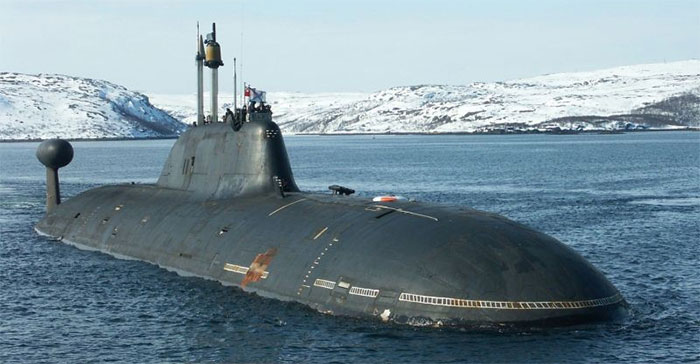How to escape the submarine in distress?
How to free the submarine crew in an emergency?
Submarine accidents are rare, but an incident often leads to life-threatening situations for the entire crew. Therefore, the solution to the problem of survival in a modern submarine is always of great significance in the general context of the completion of the submarine fleet.
Most modern submarines are designed so that if the main ballast tanks are filled with water, they will retain their buoyancy. If the submarine cannot continue moving, it can still surface.
But if a large amount of water gets inside the submarine, sooner or later it will be saved from sinking, avoiding the effects of extreme pressure.
The life of a crew is core
Experts have pointed out some of the most dangerous situations during the ship's sinking, uncontrollable: submerged submarines, increased pressure, temperature changes, toxicity appear. in the air, the ship's life support system was broken. The above risks directly affect the time allowed for the existence of crew on submarines.
In the early part of submarine history, submarine crews were actually 'suicide soldiers': a large number of submarine crews died.

Submarine accidents rarely occur.
During World War II, the only way to escape the sunken submarine was torpedo catapults, but that was not easy. Usually, sailors who are in distress die.
The most important thing is to keep the lives and ensure the health of the crew members, which is why a lot of attention is focused on submarine escape issues.
Naturally, preventing an emergency situation is easier than trying to overcome it, so the arrangement of weapons, stealth capabilities, electronic warfare systems, navigation, etc. are special. Attention right from the design of submarine. Evacuation capabilities and measures are specially studied.
Evacuation compartments are located at the bow or submarine end , where special equipment is used for emergencies.
These are the signaling devices, oxygen supply and carbon dioxide absorbers, personal emergency radio beacons, rescue kit, equipment to be admitted to the emergency assistance compartment, etc.
Rescue compartments emerged
One of the most important means to increase the crew's survival in emergencies is the submarine's emergency evacuation compartment.
In Russia, such a compartment was first tested in 2014: in addition to a 5-person test team, an additional weight was equal to the weight of the entire crew. submarine.
Rescue chambers are now fitted to all modern Russian submarines under construction. This invention by Soviet designers was truly invaluable because this rescue chamber could save the lives of all members of the submarine crew.
However, as the tragedy on the K-278 'Komsomolets' nuclear submarine in 1989 showed: the rescue compartment is not a panacea. The rescue compartment was still sunken, resulting in the deaths of many crew members.
On 12 August 2000, the nuclear submarine 'Kursk' sank and the rescue chamber did not help the ship.
However, testing of the new rescue compartment on the nuclear submarine 'Severodvinsk' has produced very good results: it only takes 10 seconds for the rescue compartment to float to the surface.
Participants compared how they felt during the relief compartment emerging as if they were going up a conventional elevator.
Inside the modern submarine "Yuri Dolgoruky" , the rescue compartment is located behind the missile bay. Inside the cabin, there are numbered seats assigned to each crew member and backup personal food and drink.

There is a stock of food in every modern Russian submarine's cabin.
Stock up on food and special rafts
In each compartment of modern Russian submarines, there is an emergency food reserve that can be used for a week.
Each sailor also has a handheld breathing device to act in the first minute when there is a fire or toxic substances in the air. The mission to perform in an emergency is to connect to the submarine's backup breathing system.
In addition, the submarines also have special rafts , each designed for 20 crew members. On each raft is equipped with the equipment necessary to survive in the ocean: niches to collect rainwater, fishing gear.
Talking about survival in a modern submarine could not help but touch the psychological aspect, because no modern equipment and means of escape can replace the cohesion and stamina of sailors. group.
Although today's automation and robots gradually replace humans in many things, the human factor is still nonetheless decisive.
Therefore, NATO military psychologists, in the course of studying the experience of using submarine crews in operations in the Persian Gulf, realized the importance of sustained psychological training for crew before battling.
At the same time, the psychological comfort of the crew depends largely on the living conditions created on the submarine.
- The way the submarine sends a signal for help in distress
- 17 submarine and one-man submarine surprises you
- Stingray ray submarine
- The truth about Chinese submarine technology
- Submarine K-27 - Soviet
- The historical secret of the world's first submarine
- The Nereus submarine exploded at a depth of 10,000m
- German submarine explosion: Mysteriously challenging the maritime industry for nearly 100 years
- New personal submarine
- The secret escapes when boats sink in the sea
- Do not know how to swim, flip boat, do anything to escape death?
- HMS Artful - World's largest nuclear submarine
 'Fine laughs' - Scary and painful torture in ancient times
'Fine laughs' - Scary and painful torture in ancient times The sequence of numbers 142857 of the Egyptian pyramids is known as the strangest number in the world - Why?
The sequence of numbers 142857 of the Egyptian pyramids is known as the strangest number in the world - Why? History of the iron
History of the iron What is alum?
What is alum?